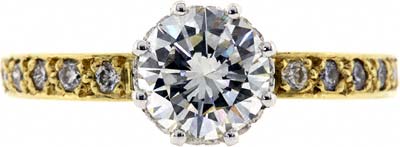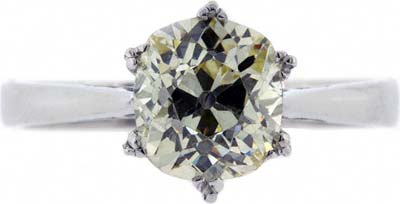| The Very Highest Quality Diamond Information... |
| Diamonds - The 4 C's - Colour |
|
|

|
|
|

|
|
|
Are Diamonds White?
It is commonly believed that most diamonds are white, although strictly we should say colourless. This is incorrect, most diamonds actually show at least a trace of body colour, and many are quite deeply coloured. To their credit, De Beers do point out that most diamonds are faintly yellow, however many diamonds are faintly brown, green, grey, or other colours.
Is White Best?
It's really a matter of personal preference. Because De Beers promote white as being the most expensive colour for diamonds, most people blindly believe that white is best, and some even believe that yellow is bad! While it is generally true that colourless diamonds are more expensive than tinted diamonds, it is not true that they are better, just that there is a difference. Many distinctly yellow diamonds are very bright, sparkling, attractive and desirable.
What About Fancy Colours?
Intensely coloured diamonds are very rare, and are also very attractive and desirable. Because they are not actively marketed, certainly not by De Beers, knowledge levels and demand for them is relatively low. Even so, they command high prices, often much more than colourless diamonds. These intensely coloured diamonds are known as "Fancy" coloured or "Fancies". They exist in yellow, greens, brown, red, orange, blue, and other colours. Also some diamonds with faint or pale colouring are rare and desirable, these colours include pink and blue.
It is our own opinion that the main reason De Beers do not promote colour as a positive attribute in diamonds is that most diamonds are near colourless, and fancy colours are so very rare. Promotion of colour would risk educating consumers to appreciate coloured stones, and this may divert demand away from diamonds, and in the direction of ruby, sapphire, emerald, amethyst, opals, and other naturally coloured gemstones.
Some coloured diamonds can be treated by irradiation and heat to change or intensify their colour. These are termed as treated fancies, and can be bought for lower prices than natural fancies.
Naturally we have a page about coloured diamonds.
What About Fire?
The ability of a diamond to refract and disperse white light into all the rainbow colours of the spectrum is sometimes called "fire", and it is one of the desirable qualities of diamonds. Well polished diamonds sparkle and flash with lots of fire. It is easy to confuse this aspect of colour with the "body" colour of a diamond. So what do we mean by "body" colour?
What Is "Body" Colour"
Body colour is simply the colour seen when white light travels through the diamond without being dispersed, rather than the multi-coloured flashes caused by dispersion. Body colour is best judged by viewing the stone through the side rather than through the top. It is the colour which the diamond would appear if it were not facetted, and is the stone's true colour. The "fire" actually confuses the eye, and makes it almost impossible to judge the body colour. The term "body colour" is only used to emphasize which aspect of colour is intended, when the word colour is used, it normally is understood to mean body colour.
Colour Grading
In recent years, a de-facto international standard grading system has evolved, based on the standards of the G.I.A., the Gemmological Institute of America. Terminology differs in European standards, but the grades are identical.
The following table shows the GIA, traditional UK, and CIBJO colour scales, together with our graphical representation. We have assumed that your computers video card can display at least 256 shades of colour. Obviously this chart may appear different on different monitors, therefore it is advisable to treat our colour column in the table as only a general guide rather than as an exact rendition of any particular colour.
| GIA | UK Traditional | CIBJO | Colour | Our Comments |
| D | Finest White | Exceptional White + | Colourless | |
| E | Finest White | Exceptional White | Virtually Colourless | |
| F | Fine White | Rare White + | Virtually Colourless | |
| G | Fine White | Rare White | Virtually Colourless | |
| H | White | White | Virtually Colourless | |
| I | Commercial White | Slightly Tinted White | Very Faint Colour | |
| J | Top Silver Cape | Slightly Tinted White | Very Faint Colour | |
| K | TSC to Silver Cape | Tinted White | Faint Colour | |
| L | Silver Cape | Tinted White | Faint Colour | |
| M | Light Cape | Tinted | Increasing Colour | |
| N | Light Cape | Tinted | Increasing Colour | |
| O | Cape | Tinted | Increasing Colour | |
| P | Cape | Tinted | Increasing Colour | |
| Q | Cape | Tinted | Increasing Colour | |
| R | Cape to Dark Cape | Tinted | Increasing Colour | |
| S-Z | Dark Cape | Tinted | Deep Colour |
Most people would find it difficult to differentiate between diamonds in the first four colour grades, D, E, F and G, even when unmounted. Mounted diamonds of these grades, and also H and I appear colourless. The ability to notice any colour in these grades will vary with the colour perception of the individual.
Small mounted diamonds down to J and K colour will usually also appear colourless except under careful inspection, and then only by those with good colour perception. Slight colour may be visible in larger stones.
Lower colour grades will show increasingly noticeable colour, although well proportioned stones may appear lighter viewed from above, when mounted, than their body colour would suggest.
Standard scales do not yet extend to brownish diamonds, or diamonds of other colours.
Diamond 4C's Tour - Next Stop - Clarity
Diamond Glossary - An A to Z of Diamonds
| ...at the Lowest Possible Price |
|
32 - 36 Harrowside, Blackpool, Lancashire, FY4 1RJ, England. Telephone (44) - (0) 1253 - 343081 ; Fax 408058; E-mail: The URL for our main page is: https://24carat.co.uk | Chard(1964) Ltd |